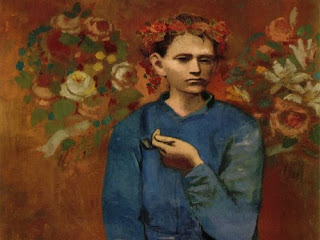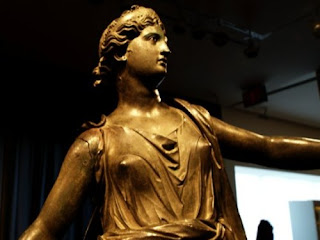My son, nephew, niece, and daughter,
Louvre, Paris, France (2012)
The walls that house the spoils of war and treasures of the world, when seen with an Alice In Wonderland-like perspective, can indeed feel a bit strange.
Transplant an urban, American teenager from their natural habitat and drop them unprepared into the jungle of history, and it might look and feel a little like this:
In Night At The Museum, Hollywood, on what I consider a rare occasion, actually imparted - in their classic, stylized way - a valuable idea, unleashing onto the general public knowledge early western scholars and church leaders fought so hard to keep hidden from the masses, namely: the idea that there's more knowledge out there than we realize.
Everyone likes a good story and museums are filled with them. Still, like anything worth excelling at in life, we can't just "show up" unannounced and passively expect the environment to edify and enlighten us; to tell us its deepest, darkest secrets without our first doing a little digging, decoding, and deciphering of our own.
My Daughter, Puebla, Mexico (2011)
Just as an athlete makes sacrifices, getting up every morning at the crack of dawn to head out to practice when they could have easily stayed in bed for another hour or two...
...we have to go to great lengths to bring the museum to life. Like anything worth doing or learning, it is us who have to make the effort if we want to see results. We've got to hitch a ride on a jeep and explore the jungles of Mexico (or the outskirts of wherever we live) to appreciate the treasures that were found in the region, hauled across large distances without the means of modern transportation, finally finding their way into museums where they are now visible to the demanding public all over the world.
Me
Becan Mayan Ruins, Mexico (1994)
The next best thing to taking a voyage for ourselves is being swept away by someone's story about a grand journey they took.
My daughter, son, and me
Puebla, Mexico (2011)
Museums hold the treasures ancient peoples either created or looted from all over the world: from Solomon's temple to the cave that hid the treasures of Ali Baba and the Forty Thieves, many of these objects are still finding their way out of obscurity, away from the hands of private collectors, and into the museum environment, the public custodians of humanity's history.
If you are a book lover, a person with an affinity for the written word, you might consider a trip to Puebla, México, to Palafox's Library, the first public library established in the Americas (1646), as a trip worth making. Just like museums, libraries, national monuments, churches, cathedrals, abbeys, and ruin sites preserve something of importance.
We all, at some point in our life, question our origins and our future trajectory, we make sense of both uncertainties by connecting ourselves to what is certain, to the tangible aspects of reality, to our collective humanity. In the absence of a physical or existential servitude, we connect and serve one another.
My daughter, Palafox Library,
Puebla, Mexico, 2011
In doing so, we uncover a world that unleashes our imaginations back to the sheer flamboyancy society previously lavished upon treasures of the mind, objects of worth, and those so-called creations someone labeled "treasures".
The sensitive piety, the ostentatious monuments decorated by Michelangelo and Raphael, and the reverence that was displayed in the past were the reasons why these palaces, châteaus, and cathedrals were erected in the first place - to house the treasures and spoils of war for enjoyment and reflection.
Museums continue to offer both of these qualities in abundance. A quiet place for contemplation as well as a meticulously perserved environment whereby treasures are safeguarded for the continued enjoyment of future generations.
Once upon a society, all property - tangible and intellectual - had a deeper value because of the worth we ascribed to it, to its significance, to the progress it inspired, or to the reverence it revealed within us.
Sold in 2004 at Southeby's auction for $104.1 million,
Boy with a Pipe (The Young Apprentice),
Pablo Picasso, 1905.
In 1994, Microsoft founder Bill Gates purchased Da Vinci's historic manuscript for $30,802,500.
In 2007, Artemis and the Stag became the highest priced sculpture ever sold at auction when an anonymous buyer purchased the relic for $28.6 million. The sculpture is over 2,000 years old and hails back to the Roman empire.
The Back Story:
In the 1920's, a team of construction workers stumbled upon this sculpture while digging in Rome. I bet they wish they'd had been the ones to sell it at auction! You might enjoying knowing that the auction house thought the piece would only go for about $7 million. Boy were they wrong!
It has been my experience that anyone who has experienced a degree of profundity in their lives, automatically embarks on a road of appreciating it - in its many forms - in others.
Me
Kyoto, Japan (2007)
As we find this quality in ourselves, our exploration of the world takes us further.
The works of art we have the privilege of viewing in museums inspires our minds beyond the mere spoils of war, beyond the wildly adventurous treasure hunts about which we love to read, they inspire our imagination in a way that yields to newer human creations.
Jules Vernes Nautilus Inspired Metro Station
Arts et Métiers, Line 11
Paris, France
The love child of history and technology was science fiction. Jules Vernes' Nautilus (the impetus for writing we have George Sand to thank) was inspired out of Vernes' imagination - a combination of his appreciation for history combined with his love of futuristic technology (as seen in the gadgets he included in his tales; gadgets he saw at the various World Fairs he attended).
Vernes didn't have the many adventures about which he wrote, but that didn't diminish the profound appreciation we had as a society for his writings ... for we, too, took those adventures with him. He took readers along on the rides of their lives, from the comfort of their own home.
Seeing old things in new ways is at the heart of science fiction. For a generation captivated by the possibilities inherent in the technological advancements of our age, the museum is a rare gem, a cultural landfill offering a plethora of material from which to create humanity's next greatest science fiction story. Science fiction we love to turn into reality.
In the days of Jules Verne, ordinary citizens understood more about the worth of an item, the craftsmanship that went behind the making of an object they held in their hands, and the difficulty one must undertake to come into possession of one of these items in the absence mass production.
In response to the concept of 'museums sucking,' I'd have to say that, in all reality, it is mass produced items that 'suck' the life out of this generation's knowledge of the true craftsmanship that goes into making what we consider ordinary objects. A craftsmanship dying out faster than I can write this article.
My son and daughter
Château de Vincennes (2012)
On a side note, I have made a point to visit many of these 'last mastercraftsmen and women' of Europe, trade families who have survived generations and sometimes centuries of political unrest. Taking my children along for the visit, they often times leave with mixed emotions. Appreciation for the value of the work, the opportunity to learn more about our global history as it relates to culture, society, the arts and material progress, as well as the sobering recognition that they might never see it again. That few people will have the opportunity to traverse in their shoes and gain the personal appreciation they have for our past, for the collective history of humanity from whence even the most technologically driven among us derive.
My son
Versailles (2012)
Perhaps it all comes down to a matter of taste. If you enjoy the plasticiness of pop culture, don't leave home, don't go to museums, just sit back and experience the world digitally - online. There will be less people for me to wait in line with in these locations if you do.
However, if you, like me, enjoy a good story about a treasure hunt, intrigue or mystery; if you value the history of humanity, our collective history...
...then pay homage to your local museum by going for a visit. Not for the sole purpose of making fun of those who are there in search of their own adventures, but to explore - for yourself - the furthest regions of our world from the comfort of your own community.
Hiking with the kids
Tepoztlán, México (2010)

.jpg)

.jpg)
.jpg)








.jpg)



.jpg)


.jpg)


.jpg)






.jpg)
.jpg)